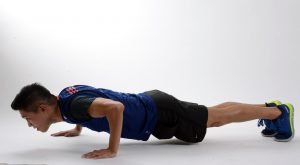Hey, how are ya feeling today? Really, we want to know! Are you a bit tired (we know that feeling), feeling down in the dumps, or filled with anxiety? Are you just totally jazzed to be alive (we hope so!) or ticked off at the world in general? Now that you’ve taken a moment to think about your mood, take a moment to think about how you’re feeling about getting your workout in. If that feeling can be summed up by a sound like “meh,” or “nah,” maybe you need to find the right workout for your mood!
It’s Not All About Endorphins

We all know the physical benefits of exercise by now, and maybe even a lot of the mental health benefits, as well. It’s all about the endorphins, right? Well, yes and no. Endorphins, those natural painkillers that get released when your body is under stress, can give you that happy feeling sometimes known as “runner’s high,” but it turns out that they don’t kick in for everyone during every workout.
It turns out, according to recent studies, they come into play only during activities done at certain intensities or for certain durations, and what triggers them can actually vary from person to person. For example, a recent study showed that a brief HIIT session triggered more of an endorphin rush than an hour of moderately intense cycling did, with some participants getting a surge of endorphins at lower intensities than others did.
So why are we telling you this at the same time that we’re encouraging you to workout? Because these results aren’t necessarily a bad thing, they just go to show that it’s important to match your workout to your mood, maybe by choosing activities that prompt other positive responses, including the release of “happy hormones,” and/or an instant shot of energy.
After all, an endorphin rush is just one way movement can boost your mood and decrease those bummer feelings. Or, sometimes exercise can help you to work through the feels, especially if those feels involve anger, and are making you want to throw something – or someone – out the window. But save your strength! And check out the best types of workouts for whatever your mood might be.
The Right Workout for All the Feels You’re Feeling
We know exercise can lower stress hormone levels, reduce symptoms of anxiety and depression, improve confidence, distract you from negative thoughts, and boost your mood, to name a few of the mental health benefits. And the great thing is that studies show that exercise actually helps promote the growth of new neurons in key areas of the brain, including the hippocampus, so it could be possible to keep mental health issues at bay, just by getting your daily sweat on.
But first, you’ve got to lace up those sneakers and get it done, and that means working out in the way that’s right for the headspace you’re in that day, whether it means using your feelings to get more out of your workout, or using your workout to get the most out of your feelings.
Your mood: Down in the dumps
Feeling low, blue, blah, low energy? You’re probably not going to get much out of an intense burst of HIIT, even with the possibility of an endorphin rush – and you’re probably not going to be able to convince yourself to do it, anyway.
Your workout: Steady-state cardio
Try instead what’s known as steady-state cardio, like a jog, or even a walk if that’s all you can muster today. While you probably won’t get a rush of endorphins from a more moderate workout, even if it’s a bit longer than a HIIT session, you probably will trigger the release of some other feel-good chemicals, like dopamine (the chemical responsible for feeling great when you satisfy your urges like eating something delicious or having sex) and serotonin (the chemical that’s flowing through you when you laugh or feel the sun shining on you).
Try to choose something that will also bring you joy, whether that’s walking at sunset, hiking, jogging on the beach, getting together with a friend and doing a sport you enjoy, or even trying some dance cardio. Remember to keep at it for more than 10 minutes, and hopefully for at least 30 – you can do it!
Your mood: Full of frustration
Feeling ready to scream? Yeah, we know that one – everything in your day just seems to be going wrong, and while you’re not exactly angry, you’ve got that balled-up feeling inside that just feels ready to burst out the next time you drop something or something doesn’t work out the way you wanted it to. That feeling requires opening a release valve!
Your workout: HIIT
No steady-state cardio for you today, you need the full-on cocktail of endorphins, serotonin, and dopamine that comes with an all-out workout. So try something intense that challenges your body, like high intensity interval training, or HIIT. This type of workout usually involves doing short bursts of super intense activity, followed by even shorter rest periods (think: 50 seconds of burpees followed by 10 seconds rest, then 50 seconds of squat jumps followed by 50 seconds rest, etc).
The chemical reactions triggered by working out like this can help you cope by squashing frustrating feelings, and the focus required to finish a challenging workout can take your mind off your problems. Bonus: HIIT workouts tend to be shorter, so once you’ve released your frustrations, and boosted your mood, you can get back to your day and turn things around!
One word of warning from the experts: just be careful not to push too far past your usual effort level. One study found that going overboard can increase negative feelings, because you could end up putting too much stress on your body, leaving you feeling bummed out. To give you some idea of what might be too much, one study found that pushing your heart rate over 90% of its max for more than 40 minutes a week is linked to irritability and can increase your risk of injury.
And one more note: some experts also suggest using some other psychological tactics other than just distraction to get the most out of your workout on a day when you’re feeling frustrated. For example, try changing up the order you usually do things to give yourself a psychological boost. How? According to Ted Butryn, Ph.D., an assistant professor of sports psychology and sociology at San Jose State University, “Starting your routine with…exercises that you usually do after your muscles are exhausted makes it easier to use more weight during those exercises. This changeup can leave you feeling stronger than usual, giving you the psychological boost you may need to keep exercising that day.”
Your mood: Anxiety alert
Uh-oh. You’ve got that feeling in the pit of your stomach again. Anxiety has reared its ugly head, and your mind is racing, going to all of the worst case scenarios you can possibly imagine. Now’s not the time to try to learn an upbeat dance routine, you need to clear your mind.
Your workout: Uncomplicated cardio
When anxiety hits, it’s time for you to hit the treadmill, or the road for a jog or bike ride, or do any other type of uncomplicated cardio, but at perhaps a higher intensity level than you would if you were feeling blue. Doing aerobic activity like this helps to clear your mind: “Not having to be too creative about your exercise will leave you more time to think through whatever’s causing you that anxiety,” says Richard Marsella, Ph.D., author of Welcome to Stress Management. 
We do want to point out that some experts recommend weightlifting for stress, because it requires you to be more mindful as you slow down and focus on your movements and on keeping good form. In fact, some research points to the possibility that strength training may lead to improved regulation of the system that handles your happy hormones, which could help you better handle stress over time. But there is other research that shows that you should be careful with weightlifting when you’re dealing with stress’ more jittery cousin, anxiety. According to psychologist Keith Johnsgard, “Research has shown that weight lifting can sometimes elevate anxiety levels for as long as one hour afterward, whereas aerobic exercise can lower anxiety levels way below their baseline.”
Your mood: Totally unproductive
Can’t seem to get yourself motivated? Just sitting there, staring at your computer screen, getting nothing done, and feeling like you’re phoning everything in? Don’t mindlessly choose a run on the treadmill, which could end up feeling like more wasted time, make yourself feel accomplished!
Your workout: Compound strength training
To give yourself that feeling of accomplishment, try a workout that includes compound exercises, or moves that target multiple muscle groups at once, and trick your mind into getting into gear. These types of moves include multi-functional, strength-training moves like rows with lunges, step-ups with bicep curls, burpees, single-arm renegade rows, squats with overhead presses, and so on. According to trainer Meghan Trainor, “Add as much spice and pizazz to reset your mind into feeling productive and accomplished. You can always modify for your fitness level, but make it challenging and surprise yourself with how well you do.”
In addition, if your productivity problem is related to feeling overwhelmed, you might want to also try something that involves breathwork, like yoga, Tai Chi, pilates, or simple stretching, which can help calm your nervous system. You can even do these types of exercises as a cool down, and do double duty for your mood!
Your mood: Aggressively angry
Ok, now you’re p***ed. You’re not just frustrated, you’re ready to bite anyone’s head off who gives you a second look. Time to not only work through those feelings, but also use them to get the most out of your workout.
Your workout: Weightlifting, HIIT, or Kickboxing
You’re going to want to get some of that aggression out, so yes, HIIT, or even a kickboxing-style workout, are great choices to let off some steam. But you might also want to consider starting out with a weightlifting routine. Anger actually makes you feel stronger; it elicits the greatest fight-or-flight response from your body, so you can use that hormonal surge for more strength. Use that adrenaline spike to try lifting a little heavier, or adding a few more reps – just remember to keep good form and listen to your body.
Your mood: Finding fault…with yourself
Feeling self-critical? You’re probably just going to end up beating yourself up if you can’t accomplish what you want to do (and you might not feel so jazzed about getting outside in a skimpy workout outfit for all to see). But there are actually exercises proven to help.
Your workout: Hatha yoga
Did you know that there are such things as “power poses,” or stances that give you an instant feeling of strength, energy, and confidence? While the mechanisms of how they work are still a bit unclear, researchers have found that postures like standing tall with your hands on your hips can have a physiological and behavioral effect that can increase your feelings of power. And you know what? Yoga poses that are similarly expansive, when held for just 2 minutes, can be beneficial too, increasing your self-esteem and energy, per other research.
So if you’re having a day when you’re being super hard on yourself, and can’t seem to do your usual workout, try Hatha yoga. This practice emphasizes holding static poses, giving you enough time to settle into your sense of strength and stability.
On a final note, if you’re having an absolutely smashing day, we are so happy for you! In that case, you’re probably already feeling great about working out, and maybe even have your favorite type of movement all lined up. Awesome! But don’t just go through the motions: when you’re feeling good, it’s time to raise the bar (no pun intended). Lift heavier or add more sets, do weightlifting exercises on one leg, run faster, farther, or both. The feel-good chemicals you release plus the feeling of accomplishment you get from upping the ante will be like compound interest on your good mood!
And really, what it all comes down to is doing what feels good to you on that particular day, in that particular moment and headspace. Science tells us these are probably the best movements for these moods, but you also have to do you! The most important thing is to get moving, because – trust us – you’ll feel better once you do.